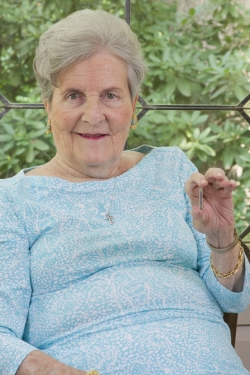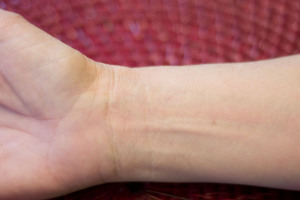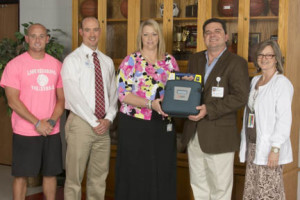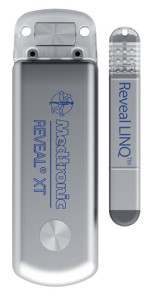STAYING AFLOAT – Ruth Deaton Receives World’s Smallest Heart
Monitor to Help REVEAL the Cause of Stroke

Ruth Deaton holds a miniaturized insertable cardiac monitor like the one
she received in July to help determine if irregularities in her heart
are responsible for a stroke she had in May
Ruth Deaton has been surrounded by accomplished surgeons her whole life.
Her father, Glen R. Frye, was a surgeon. Her husband Hugo Deaton and son,
David Deaton are also surgeons. At the age of 81, Mrs. Deaton’s
contemporaries covet the expert medical advice and wealth of knowledge
upon which she bases decisions about her personal health care. Such decisions
became of paramount importance in May 2014 after a left hemisphere cryptogenic
stroke left her facing months of rehabilitation.
Both of Deaton’s parents died following a stroke, so she is acutely
aware of the consequences she could face if a subsequent, more damaging
stroke occurs. Along with her husband and son, she began working closely
with doctors to uncover the cause of the cryptogenic stroke and develop
an aggressive treatment plan to prevent another stroke. By definition,
a cryptogenic stroke is one of unknown origin.
Deaton remains focused on a goal that she and her husband set during their
50 years sailing up and down the Atlantic coast. “I’m his
first mate,” said Mrs. Deaton. “We don’t sail anymore,
but Hugo and I still have the goal we set during those sailing adventures.”
That goal, Deaton says, is to “stay afloat”.
Recovering from the stroke has been both victorious and challenging. Although
she still has some difficulty balancing, walking, and speaking clearly,
Deaton is determined to regain the best quality of life possible. She
and Dr. Deaton were preparing for an upcoming 14-day beach trip at the
time of this interview.
Deaton’s neurologist referred her to Brian Steg, MD, a cardiologist
practicing with
Catawba Valley Cardiology, to explore the possibility of correlated irregular heart activity as
the source of her stroke. Dr. Steg recommended using an insertable cardiac
monitoring system called Reveal LINQ, a device approved by the FDA in
January 2014. Dr. Steg is among the region’s first cardiologists
to adopt this technology, hailed as the world’s smallest heart monitor.
Since March, all of the cardiologists at Catawba Valley Medical Center
(CVMC) have embraced the simplicity of inserting the tiny wireless device
just beneath the skin through a tiny nick.
“If we can pinpoint the cause of stroke, we then can apply the most
appropriate treatment and help minimize the risk of a subsequent, possibly
more damaging, stroke,” said Dr. Steg. “For example, detecting
atrial fibrillation after a stroke is helpful because there are blood
thinners that specifically reduce the risk of stroke.”
In July, Mrs. Deaton underwent a 10-minute outpatient procedure at CVMC
under local anesthesia during which she received a Reveal LINQ device
capable of recording her heart activity continuously for up to 3 years
with data transmitted wirelessly to the staff at Catawba Valley Cardiology
for interpretation and action if necessary.
Traditionally, a heart monitor involved having a patient wear a bulky portable
monitoring device to detect episodes of sporadic irregularities in heart
activity. Those devices were limited because they became uncomfortable
when worn for long periods or the adhesive electrodes required would become
displaced, limiting the integrity of a recording.
For more information about the
Medtronic Reveal LINQ insertable cardiac monitor, patients may contact Catawba Valley Cardiology
at 828-326-2354. The multimedia link below shows the process used to insert
Reveal LINQ.
Susan Bolick – A comfort-focused heart procedure
Wednesday, Dec. 12, 2012 is the day Susan Bolick’s life changed.
She had an upper-respiratory infection that turned out to be a serious
situation with her heart. Upon admission to the critical care unit a few
days later, she learned about the radial heart catheterization procedure
only being offered regionally at Catawba Valley Medical Center.
In mid-2012, Dr. Luke Byrnes of Catawba Valley Cardiology became the first
cardiologist in the region to perform a radial heart catheterization –
a revolutionary diagnostic and treatment technique for coronary artery
disease. This innovative method, which goes through the wrist as opposed
to the femoral artery in the groin, reduces recovery times, bruising and
the risk of severe bleeding.
It was Dr. Byrnes who visited Susan in December, suggesting the procedure
as a way to determine what was happening with her heart. Susan explained,
“At that point, we didn’t know if I was having a heart attack
or what? I looked at him in stunned silence while I tried to process his
request. I never expected to have my name and heart cath in the same sentence.”
She finally responded, “I have no cardiovascular disease risk factors.
How can this be happening?”
Susan was not only feeling bad, but shocked by this development. “Dr.
Byrnes was patient with me as I tried to get my head around what was going
on in my body! He came across very humble and concerned. It gave me the
confidence I needed to trust him to proceed.”
 Byrnes says comfort is another major advantage to this new procedure. “Being
able to offer the radial access, gives our patients a more comfortable
option. If someone has back pain, for instance, the need to lie flat for
hours following the procedure has been eliminated. Plus, working people
can get back to their job more quickly. In the future, we see people being
able to have same day discharge.”
Byrnes says comfort is another major advantage to this new procedure. “Being
able to offer the radial access, gives our patients a more comfortable
option. If someone has back pain, for instance, the need to lie flat for
hours following the procedure has been eliminated. Plus, working people
can get back to their job more quickly. In the future, we see people being
able to have same day discharge.”
Susan recalled the procedure, “The cath team placed me on the table,
under what looked like a giant Styrofoam box above my chest. They gave
me medicine in my IV that relaxed me while I laid there awake and watching.
Dr. Byrnes was on my right and I could see the monitors on the left. I
was able watch the catheter go into my heart and I could see the puff
of dye they used to check the blood flow.
“I couldn’t believe it, but I felt no pain. It is hard to imagine
that someone could be inside your heart and you cannot feel it! What I
remember most is how at times, I felt Dr. Byrnes gently patting my wrist.
It felt like he was comforting me and I thought, ‘how sweet’,
but then I realized he was probably wiping up blood.”
In the end, Susan was diagnosed with Myocarditis. “It was a scary
time! Most people complain about being in the hospital, but I tell you
I was so thankful to be there. I was so physically wiped out that I couldn’t
get out of the bed or even sit up. My nurses gave me such confidence because
they were both technically competent and compassionate as they looked
after me,” Susan said.
CVMC Takes Action to Save Young Lives at Arndt and River Bend Middle Schools

Pictured (L-R): Brandon Harbinson, Arndt Athletic Director, Marcus Osborne
LAT, ATC, CVMC’s Director of Sports Medicine, Angela Williams, Arndt
Principal, Carl Becker, RT(R), (CV), Director, Angiography Services at
CVMC, and Margaret Sides, Arndt School Nurse.
Catawba Valley Medical Center (CVMC) has recognized the need for on-site
emergency care at area middle schools, and has provided automated external
defibrillators (AED) as a result. An AED is a transportable, battery-powered
tool used to immediately diagnose and treat people with heart failure.
River Bend and Arndt Middle Schools recently received the life-saving
devices from CVMC, for use when the schools are in operation and at athletic events.
“Immediate care is imperative when someone is having a cardiac issue,
most notably sudden cardiac arrest (SCA). These events happen to people
of all ages when we least expect them, and being prepared is the only
safety mechanism middle schools have to care for students in need,”
said Carl Becker, RT(R), (CV), Director, Angiography Services at CVMC.
“Having the ability to offer these devices to area middle schools
puts CVMC in a great position to save even more lives in Catawba County.
Working with Marcus Osborne, LAT, ATC, CVMC’s Director of Sports
Medicine, we have been able to identify those schools most in need throughout
the county.”
The American Heart Association reports 295,000 cases of SCA happen each
year. SCA is identified as an unexpected stoppage of the heart, and requires
immediate attention from an AED for survival to be possible. Established
partnerships between CVMC and area school systems brought the need for
AEDs to the forefront. Catawba County high schools have already been outfitted
with AEDs, but the need in area middle schools still exists. CVMC gifted
AEDs to Newton-Conover and Maiden Middle Schools in 2013 and provides
training for school staff.
“The time is now to provide schools with these devices,” said
Becker. “Throughout my 25-year career working in cardiology, I have
noticed that AEDs are not always a luxury schools have available. Taking
care of children needs to be a priority, and donating these AEDs should
increase the likelihood that a child would survive a heart related failure,
including SCA, in Catawba County.”
Mark Thomas – New Technology Monitors Heartbeats
 Mark Thomas, 48, suffered dizzy spells and headaches. He passed out on
a few occasions. Was his heart the issue? Cardiologists at Catawba Valley
medical Center wanted to find out.
Mark Thomas, 48, suffered dizzy spells and headaches. He passed out on
a few occasions. Was his heart the issue? Cardiologists at Catawba Valley
medical Center wanted to find out.
They placed a Medtronic Reveal LINQ Insertable Cardiac Monitor just above
his heart. The new ICM, no bigger than a pencil eraser, monitors his heartbeat.
“I started having problems a couple of years ago, but kept putting
it off,” Thomas said. “Since January it got worse.”
Thomas went to see a cardiologist for his symptoms.
“They do not know what it is,” he said. “That is one
reason they gave me the monitor.”
In less than five minutes, doctors installed the monitor.
“We have had loop recorders for a number of years for people who
pass out and we don’t know why,” Dr. Brian Steg said.
Steg said the newest ICM’s, or loop recorders, are smaller and require
less invasive surgery. The devices are designed for people with irregular
heartbeats.
The ICM is wireless and operates on a battery. It is injected into the
skin, just above the heart and sends data to the hospital. A diagnosis
can be made within days.
“If you do an EKG to monitor it, it doesn’t find the problem,”
Steg said. “It takes weeks or months of treating people to find
the problem. It (the ICM) lets us make diagnosis we wouldn’t otherwise
be able to make. If you are having a stroke and you don’t know why,
or spells of passing out and you don’t know why, this frequently
leads to an answer.”
Thomas went on the monitoring device May 9. Since then, no problems. And
that is a problem. He said he hopes an irregular episode will lead to
a quicker diagnosis.
“I never thought I’d be waiting for something to happen,” he said.